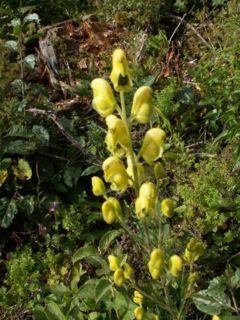Aconitum anthora
| Standard Cyclopedia of Horticulture |
|---|
|
Aconitum anthora, Linn. (A. pyrenaicum, Pall.). St. 1-2 ft.: lvs. parted almost to the base, parts deeply cut and lobed, more or less hispid beneath, smoothish above; petioles long: fls. in lateral and terminal racemes, pale yellow, often large; racemes or panicles generally pubescent; spur bent back or hooked; helmet arched, but cylindrical at base: follicles 5. June, July. S. Eu. B.M. 2654. Var. aureum, Hort., and several other varieties. A. chinense, Sieb. Deep blue spike of fls. from the axil of every lf.: foliage bold and handf-ome. B.M. 3852. P.M. 5:3.—A. delphini-folium, DC. Allied to A. Napellus.—A. gymnandrum, Maxim., is a good species. B.M. 8113.—A. Hemaleyanum, E. Pritz. Sts. twining and rambling. China. R.B. 33, p. 328. G. 32:39.—A. heterophyllum, Wall. Fls. yellow and violet. Used as a tonic medicine in India. B.M. 6092.—A. noveborarense, Gray. Probably:A. paniculatum. —A. paniculatum, Lam. (A. toxicum, Reichb.). Has blue fls. L.B.C. 9:810.—A. pyramidale, Mill. Form of A. Napellus.—A. reclinatum, Gray, of the Alleghanies, with white fls. and large lvs., is worth cult.—A. scaposum var. pyramidale. Franch. Lvs. broadly 5-lobed: fls. very numerous, 3/4-1 in. long, heliotrope, greenish yellow at the throat. Cent. China. —A. septentrionale var. carpaticum, Sims, is a beautiful purple kind closely related to A. Lycoctonum. B.M. 2196.—A. Storkianum, Hort., may be a form of A. variegatum, with the lvs. so much cut up as to give a pinnate form.—A. tortuosum, Willd. Once listed in the trade; not now found. K. C. Davis
The above text is from the Standard Cyclopedia of Horticulture. It may be out of date, but still contains valuable and interesting information which can be incorporated into the remainder of the article. Click on "Collapse" in the header to hide this text. |
| Yellow Monkshood {{{status}}} Fossil range: {{{fossil_range}}}
| ||||||||||||||||||||||||||||||||||||||||||||||||||||||||||||||||||
|---|---|---|---|---|---|---|---|---|---|---|---|---|---|---|---|---|---|---|---|---|---|---|---|---|---|---|---|---|---|---|---|---|---|---|---|---|---|---|---|---|---|---|---|---|---|---|---|---|---|---|---|---|---|---|---|---|---|---|---|---|---|---|---|---|---|---|
 | ||||||||||||||||||||||||||||||||||||||||||||||||||||||||||||||||||
| Plant Info | ||||||||||||||||||||||||||||||||||||||||||||||||||||||||||||||||||
| ||||||||||||||||||||||||||||||||||||||||||||||||||||||||||||||||||
| Scientific classification | ||||||||||||||||||||||||||||||||||||||||||||||||||||||||||||||||||
| ||||||||||||||||||||||||||||||||||||||||||||||||||||||||||||||||||
| [[{{{diversity_link}}}|Diversity]] | ||||||||||||||||||||||||||||||||||||||||||||||||||||||||||||||||||
| {{{diversity}}} | ||||||||||||||||||||||||||||||||||||||||||||||||||||||||||||||||||
| Binomial name | ||||||||||||||||||||||||||||||||||||||||||||||||||||||||||||||||||
| Aconitum anthora L. | ||||||||||||||||||||||||||||||||||||||||||||||||||||||||||||||||||
| Trinomial name | ||||||||||||||||||||||||||||||||||||||||||||||||||||||||||||||||||
| {{{trinomial}}} | ||||||||||||||||||||||||||||||||||||||||||||||||||||||||||||||||||
| Type Species | ||||||||||||||||||||||||||||||||||||||||||||||||||||||||||||||||||
| {{{type_species}}} | ||||||||||||||||||||||||||||||||||||||||||||||||||||||||||||||||||
| {{{subdivision_ranks}}} | ||||||||||||||||||||||||||||||||||||||||||||||||||||||||||||||||||
| [[Image:{{{range_map}}}|{{{range_map_width}}}|]] | ||||||||||||||||||||||||||||||||||||||||||||||||||||||||||||||||||
| Synonyms | ||||||||||||||||||||||||||||||||||||||||||||||||||||||||||||||||||
| {{{synonyms}}} |
Aconitum anthora, variously known as Anthora, Yellow Monkshood, or Healing Wolfsbane, is a yellow flowering plant species of the genus Aconitum in the family Ranunculaceae.
It's native range is widespread, but mainly in European mountains, such as the Alps and the Carpathians, and the northern parts of Asia. Like all Aconitum species, it has great variability, due to isolation and hybridisation. Because of this polymorphism, Aconitum anthora is included in the Aconitum vulparia-group. It flowers from July to September.
Historically, its root, which is tuberous, was reputed to be a good antidote, and counter-poision to poisons from 'thora'[1] or Aconitum pardalianches, whence its naming anthora or "against thora". This plant is extremely toxic to livestock and humans. Even small doses can be deadly.
The root contains a large amount of volatile salt and essential oil, while the foliage and stems contain diterpenoid alkaloids. It has been used externally against rheumatism and deep pain, but it can irritate the skin. Internally, it has been used for weak pulse, vegetable poisons (shoot), feverish colds, pneumonia, croup, heart conditions, and cardiac arrest.
It is considered Template:Fact a threatened plant in the Czech Republic.
Synonyms
- Aconitum pseudanthora Blocki ex Pacz.
- Aconitum eulophum Rchb.
- Aconitum jacquinii Rchb.
- Aconitum nemorosum M.Bieb.
References
- "Aconitum anthora". Herbal Harmony's Directory. Retrieved on 2006-01-16.
- Template:1728